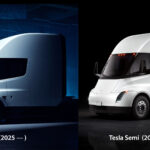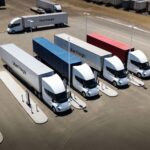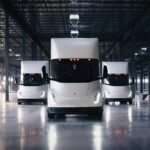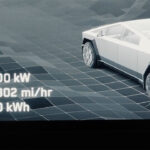The electrification of cars, vans, and buses has gained unstoppable momentum. Electric vehicles (EVs) have gone from being a passion project for early technology adopters to the mainstream, and electrification plays a central role in public policy and business strategies.
We have seen a growing appreciation of the benefits of electrification among commercial fleet customers. The availability and choice of vehicles have been improving, too. All the major car and van manufacturers have a credible EV proposition, and the eBus sector looks exciting. However, the electrification of heavy goods vehicles has been progressing more slowly.
The primary reason for this is the need for longer ranges, which require larger batteries and faster charging to make them practical. The Charging Interface Initiative (CharIN) has been working on a standard for the rapid charging of trucks and has created the Megawatt Charging System (MCS) concept which is set to address current challenges and accelerate eTruck adoption globally.

eTruck Adoption Accelerating
While the electrification of heavy goods vehicles has been slower to develop, uptake has been increasing over the past year. Many of the major truck manufacturers are busy testing fully electric heavy-duty vehicles with adoption on the verge of entering the mainstream market.
Heavy commercial vehicles are responsible for around 25% of CO2 emissions from road transport in the EU and approximately 6% of the region’s total emissions which is why it is vital that we can support the electrification of these vehicles.
In the US, medium and heavy-duty trucks account for about 29% of road transport’s total emissions – and approximately 7% of the country’s total – despite being less than 5% of the vehicles on the road. Emissions continue to rise, primarily due to the growing road freight traffic.
California is looking to incite new bans on carbon-fuel trucks in favor of zero-emission alternates to help phase out the mainstay of cargo transport at ports. Ports of Los Angeles and Long Beach are the nation’s busiest hubs for container cargo contributing huge emissions and polluted air impacting local communities. With around 300,000 trucks registered with ports, there is a huge opportunity to reduce carbon emissions from these vehicles alone.

Responding to both market and policy dynamics, major truck manufacturers have begun to set goals for the electrification of their ranges. For example, Scania’s goal is that 50% of all vehicles it sells annually by 2030 will be electric. Despite Scania being the slowest in the market with battery electric vehicles, other vehicle manufacturers are following the same target, with Volvo Trucks setting itself a target for 50% fully electric vehicles by 2030.
To achieve this goal, they will require the charging infrastructure in place so that customers have the confidence to invest in large-scale electrification of their fleets. That is one of the reasons why charging system manufacturer Kempower expects the commercial vehicle DC charging market in Europe and North America to have a 37% compound annual growth rate until 2030.
Trucks need large battery packs to give them an equivalent range to conventional engines. Charging these quickly enough is a real challenge and requires higher-powered charging infrastructure. According to ACEA, the European Automobile Manufacturers’ Association, trucks will require up to 279,000 charging points by 2030, of which 84% will be in fleet hubs. For buses, a total of up to 56,000 charging points will be needed by 2030, of which 92% will be in fleet hubs.
Megawatt Charging System Concept
The Charging Interface Initiative (CharIN) is a global association that has been working on a standard for the rapid charging of trucks for several years. CharIN has created the Megawatt Charging System (MCS) concept, which has become the basis for the ISO and IEC standards that will guide the manufacture, installation, and operation of rapid charging infrastructure for trucks.
The MCS is designed to standardize how vast amounts of charging power can be delivered to vehicles quickly. This means, among other things, that the MCS inlet will be placed at the same position in the truck – left-front side behind the first axle – to help harmonize infrastructure layouts. MCS also offers improved communication robustness, reducing downtime related to failed charging events.
Commercial vehicle fleets have very specific driving patterns. The increased charge rate offered by MCS will allow drivers to cover more distance daily by utilizing the mandated break time from the governing hours-of-service regulations to charge. These regulations state that drivers must take breaks, so reducing charging times to fit into these breaks is an enabler for improved electrification for commercial vehicles.
In its final development stage, the MCS will work up to 3,000 A and 1.25 kV to deliver up to 3.75 MW of power when charging. MCS is based on a global agreement on technical specifications, with the support of a large portion of the industry.
An internationally adopted standard is essential to drive harmonized solutions that help lower costs and increase interoperability without compromising safety and uptime.
The MCS is not focused on depot charging but more on trucks on the highway. It is a particular focus for large truck units doing long-haul routes, plus some smaller rigid trucks doing short-haul deliveries where they cross borders, such as logistics companies running deliveries between the UK and continental Europe.
While most MCS charging will happen en route as drivers break during their journeys, some depots might have one MCS charger among their infrastructure to do a flash charge if a fast turnaround of a truck is required. This unit will require 1 MW+ of electricity supply, so load management will be essential to balance the station’s demand against the other chargers on site.
Whether they are considering the implications of electrification for their vehicle fleet out on the road or depot operations, fleet operators will need to consider the adoption of MCS as part of their overall charging ecosystem and solutions.
Energy Management Crucial to MCS Success
Adopting cutting-edge technology solutions for energy management will enable effective electrification of fleet depots. In fact, implementing these solutions is the key to a smoother, more effective transition for commercial fleet operators. Energy management is essential in helping reduce energy costs, both financially and environmentally.
Investing in load management solutions will also be pivotal in maximizing existing grid infrastructure capacity and reducing the need for additional investments in generation or distribution capacity. This will be an essential factor as the electric truck fleets expand and other commercial vehicle fleets, such as buses, increase demands on infrastructure.
With unprecedented energy and investment going into electrification, 2024 looks to be a pivotal year for picking up the momentum of progress around MCS in the logistics sector. If done right, it will create a shift of optimism in the market to accelerate the electrification of commercial fleets and promises to positively impact other sectors, such as marine and aviation, contributing significantly to reducing carbon emissions.
Stay tuned for constant Tesla updates, follow us on:
Google News | Flipboard | X (Twitter) | WhatsApp Channel | RSS (Feedly).
Related
- 2026 Tesla Semi: new design, production timeline, specifications, comparison to legacy generation
- Uber Freight chooses Tesla Semi for its Dedicated EV Fleet Accelerator Program
- Tesla Semi program: factory update, 46 new Megachargers, volume production to start in 2026
- How New Regulations Impact the Electrification of the Transportation Industry
- Tesla V4 Cabinet to unlock Cybertruck 500kW and Semi 1.2MW charging speeds at V4 Superchargers
- Tesla Semi replaces diesel trucks with lower operating costs, fleet driven 7.5M km, 1700 km in 24 hours is possible, Dan Priestly at IAA








